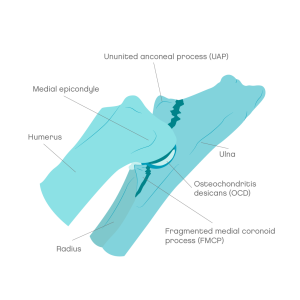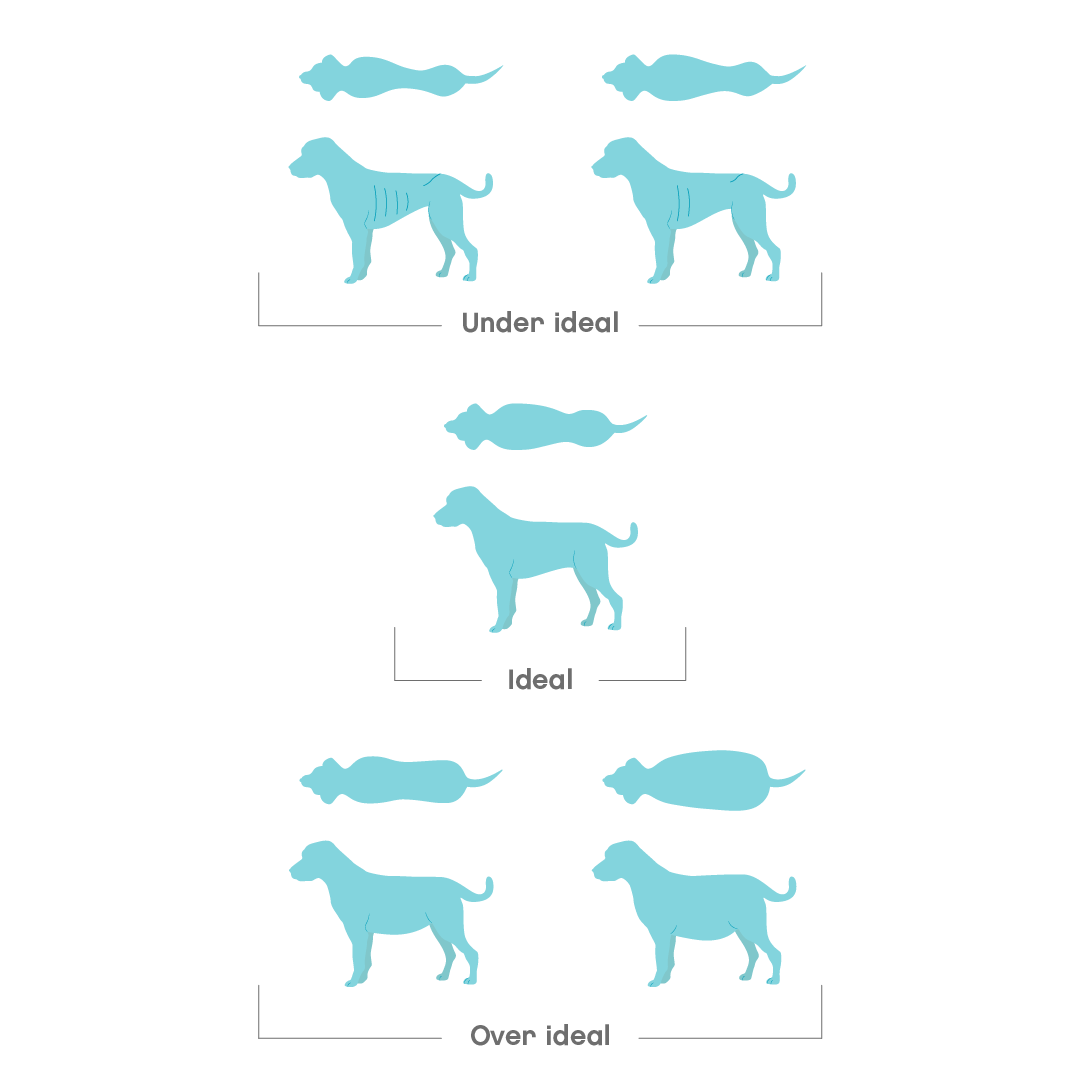Elbow dysplasia is the most common cause of lameness on the front leg in large-breed young dogs. Although it’s more common in large- and giant-breed dogs, it can also affect small and medium breeds. Dogs with elbow dysplasia often develop arthritis even after surgery, requiring lifelong management.
Elbow dysplasia is the name given to a group of conditions that affects the elbow during abnormal growth of the elbow joint. Elbow dysplasia cannot be cured but it can be well managed in order to improve quality of life.
Overview
What is elbow dysplasia in dogs?
The elbow joint is made up of three bones that come into contact: the radius, the ulna, and the humerus.

If the bones do not fit together perfectly, different problems can occur.
Elbow dysplasia consists of one or more of the following problems:
- Ununited anconeal process (UAP): A portion of the ulna bone (the anconeal process) fails to fuse during growth.
- Fragmented coronoid process (FCP): The small bony projection on the ulna (the coronoid process) is separated from the rest of the ulna by trauma or growth abnormality. This results in a fragment of bone floating in the elbow joint region.
- Osteochondritis dissecans (OCD): A piece of cartilage from the surface of the humerus becomes loose within the joint space, resulting in abnormal cartilage wear and pain.
- Elbow incongruity: The radius and ulna grow at different rates, resulting in instability of the joint.
In all cases, elbow dysplasia leads to joint wear, instability, inflammation, and eventually pain and arthritis.
With treatment, 85% of cases will show some degree of improvement in lameness and comfort despite the progression of arthritis.
Symptoms
What are the signs of elbow dysplasia in dogs?
You might notice some or all of the following in your dog:
- Limping
- Stiffness after exercise or after prolonged periods of rest
- Holding the elbow away from the body when walking
Signs often occur in older puppies (5 to 8 months of age). However, it may not be diagnosed until adulthood.
Risk
Which dogs are at risk of elbow dysplasia?
The cause of elbow dysplasia in dogs remains unclear.
Different factors are believed to cause growth disturbances, and consequently elbow dysplasia.
Among the causes are:
- Hereditary factors: Commonly seen in large to giant breed dogs such as Bernese Mountain Dogs, German Shepherds, Golden and Labrador Retrievers, among others.
- Nutrition: Puppies that grow too quickly or become obese due to inappropriate feeding.
- Trauma: High impact accident that injures the bones and cartilage.
Diagnosis
How vets diagnose elbow dysplasia in dogs
To help determine whether your dog has elbow dysplasia, a vet will:
- Talk through the history of your dog’s life
- Do an orthopaedic examination
- Take radiographs (x-rays)
Your vet may also need to refer your dog to a specialist vet in a referral hospital for more advanced diagnostic procedures such as:
- CT scans
- MRI scans
- Arthroscopy (a camera inside the joint)
Vet treatment
How to treat elbow dysplasia in dogs
Treatment consists of surgery and medical management.
Surgery is usually necessary. But in these cases, medical management still plays a very important role.
Your vet may recommend only medical treatment if the problem is so mild or severe that routine surgery is unlikely to benefit the joint.
Surgery
Often surgery is best performed using arthroscopy (using a camera in the joint), but conventional open surgery can also be done.
Surgery may involve the following procedures, depending on the problem:
- Removal of any bone fragments and removal of loose cartilage.
- Reattachment or removal of the anconeal process.
- Surgical alteration of the elbow joint to improve joint fit or shift weight away from damaged areas.
- Joint replacement if the elbow is severely damaged.
Medical management
Medical management is used to minimize pain and slow the progression of arthritis. For better results, all of the following will be needed:
- Joint supplements
- Anti-inflammatory and painkiller medication
- Weight control and weight loss
- Exercise modification
- Physiotherapy and rehabilitation
- Complementary therapies such as acupuncture, massage, stem cell therapy, and laser therapy
Home treatment
How to help your dog with elbow dysplasia at home
Keep your dog slim
It is important that your dog maintains an ideal BCS of 4-5 to prevent excessive weight on their joints.
You can achieve this by:
- Using a weight control diet.
- Making sure you are given the correct amount and frequency of food per day.
- Avoiding extra treats or choosing healthy and low-calorie treats.
- Avoiding giving human food.
- Exercising your dog enough and correctly.
- Contacting a vet nurse for guidance.
Body Condition Scoring (BCS) in dogs
Body Condition Score (BCS) is a scale that gives a practical evaluation of the fat coverage of your dogs body. By checking how easy or not it is to feel certain bony areas of the body, a score is then produced. There are several scales, from 1 to 5 or 1 to 9. The ideal body condition lies in the middle, so either 3/5 or 5/9.
The body areas normally checked for fat coverage are:
1. ribs and spine
2. hips and shoulders
3. waist

Here are a few tips on how to do it.
With your pet in a standing position:
- Place your hands on the rib cage and gently feel for each rib, without pressing too hard
- Feel the waist and look from the top and the side (if you have a very furry breed, it may be harder to assess)
- Feel the spine, which runs down the middle of the back
- Feel the top of the hips and shoulders
Controlled exercise during painful episodes
Exercise should be restricted during any flare-up of lameness.
Your dog should not run, jump, use stairs, or have any boisterous activity for a period of three weeks.
We suggest:
- Mind/puzzle games to keep them busy
- Keeping your dog on the lead
- Short walks, on average a 10 minutes walk 3-4 times a day
Cold therapy during painful episodes
Applying cold to the elbows after a flare-up of lameness can reduce inflammation and pain in a natural way.
For most dogs, applying a cold pack to the elbows for 10 minutes, especially after exercise, can be helpful.
We recommend you contact a vet before applying cold therapy to your dog.
Adapting activity levels for long-term management
In the long term, your dog may benefit from short and frequent walks, and you will learn what they can cope with.
The following guidelines are recommended:
- Adapt your routine.
- Avoid vigorous off-lead exercise, which will put excessive stress on their elbows.
- Exercise patterns should be regular: avoid short walks during the week and long walks during the weekend.
- Avoid hard, irregular landscapes and soft sand beaches. Choose flat, short grass instead.
- Avoid tricky obstacles
- Conserve energy to get home
- Take a break during the walk
So many joint supplements are available, which one should you choose?
The key ingredient a joint supplement should contain is:
- Green-lipped mussel extract (a bivalve mollusc extract)
- Omega-3&6 fatty acids (polyunsaturated fatty acids)
Other ingredients that may also have an effect are:
- DPLA (a protein that is believed to have pain relief and mood-elevating effects)
- SAMe (a compound found naturally in the body)
- CBD (an active ingredient in cannabis extracted from the hemp plant)
- Hyaluronic acid (a component of joint fluid that gives it elasticity)
- Chondroitin sulphate (extracted from mammalian cartilage, normally cow windpipes)
- Collagen hydrolysates (also known as gelatin, it’s made from collagenous structures of mammals such as bovine tendons)
- Glucosamine (a natural compound found in cartilage)
- Vitamin E
Are physiotherapy and rehabilitation that important?
In order to improve limb function and quality of life, this condition typically requires expensive surgery and physiotherapy.
Use the following links to find qualified professionals
- Physiotherapy: The Register of Animal Musculoskeletal, Practitioners (RAMP), The Association of Chartered Physiotherapists in Animal Therapy (ACPAT), National Association of Veterinary Physiotherapists (NAVP)
- Hydrotherapy: National Association of Registered Canine Hydrotherapists, Canine Hydrotherapy Association
- Laser therapy
- Acupuncture: Association of British Veterinary Acupuncturists
- Magnetic field therapy
- Chiropathy: The Register of Animal Musculoskeletal Practitioners (RAMP), British Veterinary Chiropractic Association (BVCA)
- Osteopathy: The Register of Animal Musculoskeletal Practitioners (RAMP), European Veterinary Society for Osteopathy (EVSO)
- Massage
- Homoeopathy: British Association of Homeopathic Veterinary Surgeons
- Electrohydraulic shockwave therapy
Prevention
Can elbow dysplasia in dogs be prevented?
Not all cases of elbow dysplasia can be prevented. Nevertheless, there are some steps you can take to reduce your dog’s risk of developing this disease.
Check breed characteristics:
- Research the breed before getting a new dog.
- Find a responsible breeder who performs health screening and genetic control tests.
Regular vet health checks:
- For early diagnosis and to help monitor any relevant changes.
- Puppies at high risk of elbow dysplasia need to be closely monitored in the first 5-8 months of life.
Diet and nutrition:
- As your dog grows, providing them with appropriate exercise and a healthy diet will help prevent obesity.
- It is vital that you provide your dog with the correct food and quantity based on the breed and stage of development.
- For help reach out to a vet nurse.
Exercise with caution:
- Staying fit and exercising regularly will help your dog’s muscles stay strong and reduce joint stress.
- Dogs with elbow dysplasia should never be exercised to the point of fatigue.
- Avoid high impact, sharp starts or stops, twisting, and repetitive movements such as ball throwing for prolonged periods.
Neutering guidance:
- If you plan to have your dog neutered, do so with guidance regarding the most appropriate age for their breed.
- Screening programmes are available to check that a dog has healthy elbows before mating.
- As the disease is hereditary, it is recommended not to breed a dog with elbow dysplasia.
When to worry
When to worry if your dog has elbow dysplasia
Call your vets if your dog shows any of these signs:
- Not improving or worsening despite treatment
- Loss of appetite
- Vomiting or diarrhoea, especially if taking medications
- Increased drinking or urination
- Tiredness
Joii can help with:
- identifying pain in your dog
- preventing arthritis in your dog








